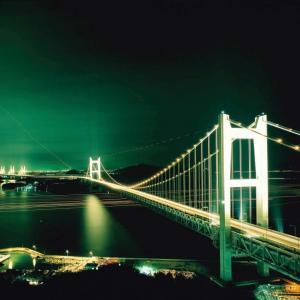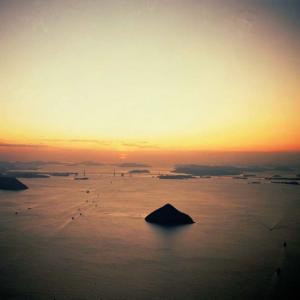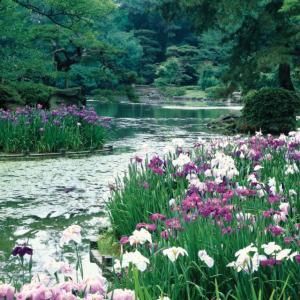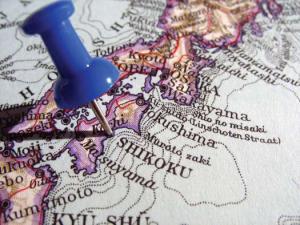Discovering Kagawa
By Andrew Cockburn
 Seto-Ohashi bridge at night -- Click on image for enlarged view.
Seto-Ohashi bridge at night -- Click on image for enlarged view.
Stretching out on the deck of a ferry as it glides serenely across the Inland Sea, it seems as if spring has finally arrived. All around, the islands which the ferry passes on the way to its destination are blooming white and pink with plum and cherry blossoms. The temperature having finally risen enough for it to be a pleasure to be outside, it was time to take a break from the city and get away for a while to enjoy a bit of natural scenery and fresh air. For me, that means heading to Kagawa Prefecture, and getting out to the hundreds of islands that spread out across the sea between Shikoku and Honshu.
Possibly the most famous of Kagawa’s islands, at least among the international community, is Naoshima, and with good reason. The island has taken the three themes of art, nature and the environment and made itself into a most intriguing place to visit. As the ferry rounds the point and heads into Naoshima harbour, the first thing many passengers notice is the giant red and black pumpkin sitting incongruously on the headland next to the ferry port. This is the first of many pieces of modern art which visitors to the island will see dotted about on the roads, beaches and cliffs.
Jumping onto the 100 bus, visitors are whisked through the main Naoshima town, and then up into the high ground on the island, where the Chichu Art Museum lies dug into the side of one of the mountains. Designed by Ando Tadao, this facility combines architecture with modern art to create a truly unique experience.  Panoramic view of the Inland Sea -- Click on image for enlarged view. The building itself is one giant piece of architecture- as-art, and this complements the other artistic installations within it. It is also very interesting to see the clever architectural tricks used to protect the most valuable pieces in the collection, such as the Monets, from light damage.
Panoramic view of the Inland Sea -- Click on image for enlarged view. The building itself is one giant piece of architecture- as-art, and this complements the other artistic installations within it. It is also very interesting to see the clever architectural tricks used to protect the most valuable pieces in the collection, such as the Monets, from light damage.
The summit of the central mountain commands a 360-degree view of the Inland Sea
Back at the bottom of the hill, Naoshima Town is host to possibly the island’s most charming feature—the IE Project. This is another set of art installations, which are spread throughout the town, housed in various old homes and other buildings. Visitors walk around the old fishing town, down narrow, twisting streets lined with charred black wooden houses (a typical building style of the area). It is then possible to stop at the art installations, or one of the delightful little cafés and restaurants, many of which are also quite well hidden. It’s definitely worth asking a local for directions to a good café. Some of the artists who contributed to the IE Project also have pieces in the Chichu or Bennesse House art galleries as well, and so there are several artistic themes which repeat throughout the island, such as the use of space and depth-of-field, and the combination of the mundane with the surreal. Naoshima is already deservedly well-known among the international community as a place to relax and take in art and nature.
Travel to the western end of Kagawa, and there is another island well deserving of a visit, the beloved Awashima. It’s an hour’s trip by car or train to Takuma in Mitoyo City, then a short 15 minute ferry ride to the island itself.  Kikugetsu tea house in Ritsurin Park -- Click on image for enlarged view. This gem of an island is still a fairly well-kept secret even within Kagawa itself, and as such is still relatively untouched. Shaped like the propeller of a ship, with three distinct projections of land around a central mountain, in spring and summer, Awashima boasts abundant nature and stunning views. The summit of the central mountain commands a 360-degree view of the Inland Sea, which includes the famous Seto-Ohashi bridge, the many surrounding islands and the Sho-nai Peninsula. During the summer months, this whole region of the inland sea is the home to Umino-Hotaru, or sea-fireflies, luminous sea-life which one can see glowing beneath the water at night. Take a dip into the warm, still water, and luminous plankton called Yakochu sparkle about your fingers, leaving green trails of fire from every movement. The last ferry departs Awashima fairly early in the evening, but there are wooden cabins run by the local government which are available for very reasonable prices, and they offer a stunning view of the Shikoku coastline and Seto-Ohashi bridge twinkling in the darkness.
Kikugetsu tea house in Ritsurin Park -- Click on image for enlarged view. This gem of an island is still a fairly well-kept secret even within Kagawa itself, and as such is still relatively untouched. Shaped like the propeller of a ship, with three distinct projections of land around a central mountain, in spring and summer, Awashima boasts abundant nature and stunning views. The summit of the central mountain commands a 360-degree view of the Inland Sea, which includes the famous Seto-Ohashi bridge, the many surrounding islands and the Sho-nai Peninsula. During the summer months, this whole region of the inland sea is the home to Umino-Hotaru, or sea-fireflies, luminous sea-life which one can see glowing beneath the water at night. Take a dip into the warm, still water, and luminous plankton called Yakochu sparkle about your fingers, leaving green trails of fire from every movement. The last ferry departs Awashima fairly early in the evening, but there are wooden cabins run by the local government which are available for very reasonable prices, and they offer a stunning view of the Shikoku coastline and Seto-Ohashi bridge twinkling in the darkness.
No trip to Kagawa would be complete without a stroll around Ritsurin Park. Originally a private garden for the Daimyo Lords who ruled the Sanuki (Kagawa) region, it is now open to the public, and while not one of the top nationally recognized gardens, it is designated as a treasure of the prefecture, and is very interesting to tour at almost any time of year (December is a bit cold, although still starkly beautiful).  Click on image for enlarged view. The park is in the Japanese tradition, with gravel walkways for visitors to follow, which reveal grand views over the three ponds which separate the park, or bring you face to face with a finely sculpted pine tree or carefully thought-out rock-garden. Ritsurin Park also boasts two tea-houses where customers can relax and enjoy the view over the largest of the ponds while sipping green tea. The most interesting part of the park is the man-made waterfall at the rear of the gardens it was originally hand-operated, meaning workers would carry buckets of water to the top of the hill and then pour them into the main reservoir at the top to then be released by hand when the Daimyo aristocrats walked past. Nowadays however, it is pumped by a machine and thus flows continuously while the park is open.
Click on image for enlarged view. The park is in the Japanese tradition, with gravel walkways for visitors to follow, which reveal grand views over the three ponds which separate the park, or bring you face to face with a finely sculpted pine tree or carefully thought-out rock-garden. Ritsurin Park also boasts two tea-houses where customers can relax and enjoy the view over the largest of the ponds while sipping green tea. The most interesting part of the park is the man-made waterfall at the rear of the gardens it was originally hand-operated, meaning workers would carry buckets of water to the top of the hill and then pour them into the main reservoir at the top to then be released by hand when the Daimyo aristocrats walked past. Nowadays however, it is pumped by a machine and thus flows continuously while the park is open.
Although Kagawa has so many treasures, it still remains a relatively unexplored area, meaning you can escape the crowds of tourists and find true peace and tranquility in an easily accessible area of Japan.
Kagawa is accessible by air, with daily flights to Takamatsu airport from Tokyo’s Haneda airport. By train, the nearest Shinkansen stop is Okayama, from where it is a one-hour trip by express train to Takamatsu station. By car, there are two main bridges onto Shikoku, the Seto-Ohashi and the Awaji Kaikyo, or there are ferries from Uno Port in Okayama to Naoshima and Shodoshima Islands, and a ferry from Kobe to Takamatsu.
For more information some useful websites are:
www.pref.kagawa.jp/foreigner.shtml
www.21kagawa.com/visitor/kangei/kagawa.htm
www.naoshima-is.co.jp/english/index.html





